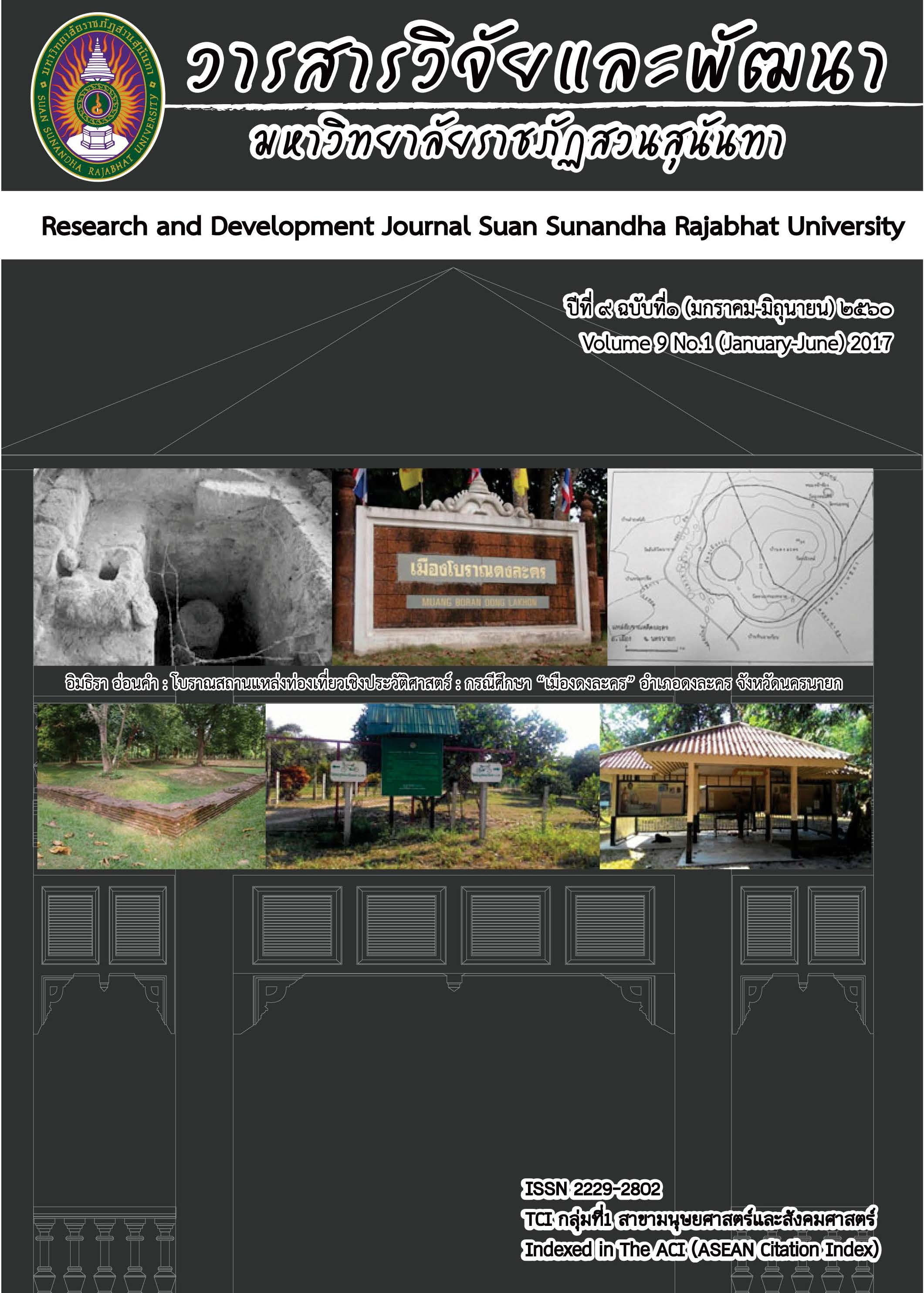รูปแบบความสัมพันธ์เชิงสาเหตุของปัจจัยที่ส่งผลต่อสิทธิคุ้มครองผู้บริโภค ที่ควรได้รับในมุมมองผู้บริโภคไทยรองรับประชาคมเศรษฐกิจอาเซียน
DOI:
https://doi.org/10.53848/irdssru.v9i1.213764คำสำคัญ:
ความสัมพันธ์เชิงสาเหตุ, สิทธิคุ้มครองผู้บริโภค, ประชาคมเศรษฐกิจอาเซียนบทคัดย่อ
การศึกษาเรื่องนี้มีวัตถุประสงค์เพื่อศึกษา 1) ระดับการเปิดรับข่าวสาร ความรู้ ความตระหนัก
และสิทธิคุ้มครองผู้บริโภคที่ควรได้รับในมุมมองผู้บริโภคไทยรองรับประชาคมเศรษฐกิจอาเซียน
2) รูปแบบความสัมพันธ์เชิงสาเหตุของปัจจัยที่ส่งผลต่อสิทธิคุ้มครองผู้บริโภคที่ควรได้รับในมุมมอง
ผู้บริโภคไทยรองรับประชาคมเศรษฐกิจอาเซียน เครื่องมือที่ใช้ในการวิจัยคือ แบบสอบถาม ซึ่งเก็บ
รวบรวมข้อมูลจากกลุ่มตัวอย่างผู้บริโภคไทย 5 จังหวัดจาก 6 ภูมิภาคใน 77 จังหวัดของประเทศไทย
จานวนทั้งสิ้น 1,014 คน วิเคราะห์ข้อมูลด้วยเทคนิคการวิเคราะห์โมเดลสมการโครงสร้าง ผลการวิจัย
พบว่า ความรู้เกี่ยวกับสิทธิคุ้มครองผู้บริโภคโดยรวมอยู่ใน ระดับมาก (xˉ = 0.69, S.D = 0.31)
ความตระหนักรู้ในสิทธิโดยรวมอยู่ในระดับมาก (xˉ = 3.65, S.D = 0.60) และสิทธิคุ้มครองผู้บริโภคที่ควรได้รับโดยรวมอยู่ในระดับมาก (xˉ = 3.92, S.D = 0.41) และมีความสัมพันธ์เชิงสาเหตุที่มีความกลมกลืนกับข้อมูลเชิงประจักษ์ ( x2 /df = 1.786, GFI = 0.934, AGFI = 0.915, CFI = 0.975,TLI = 0.952, PGFI = 0.627, RMR = 0.026, RMSEA = 0.046) ตลอดจนมีความสามารถในการพยากรณ์ได้ระดับดี เนื่องจากมีค่าสหสัมพันธ์พหูคูณกาลังสอง (R2) เท่ากับ 0.767 หรือคิดเป็นร้อยละ 76.7
เอกสารอ้างอิง
becomes the center of ASEAN
Economic Community. Bangkok:
Tammasat University
Cochran, W. G. (1977). Sampling
techniques. (3rd ed.). New York:
John Wiley & Sons.
Department Of Provincial Administration.
(2014). Registration system of
statistics. Internet Affairs. Bangkok.
Dwyer, Rachel. (2007). Expanding homes
and in creasing inequality: us
housing development and the
residential segregation of the
affluent. Social problems. 54(1),
23-46.
Frank, R. H. (2009). Post consumer
propensity : finding new
opportunities among the economic
wreckage. The American prospect.
(3,4,12). Washington, D.C.: The
American Prospect, Inc.
Freeman et al. (2012). The health of
canada’s young people: a mental
health focus. Ottawa: Public
Health Agency of Canada.
Greatorex, M. & Mitchell, V.W. (1994).
Modelling consumer risk
prefermences from perceived loss
data. Journal of Economic
Psychology. 15 (4), 669-685.
Hoogland, J. J., & Boomsma, A. (1998).
Robustness studies in covariance
structure modeling: An overview
and a meta-analysis. Sociological
Methods & Research, 26 (3), 329–
367.
Hugh, Lucey. (2004). The Corporation :
the pathological pursuit of
power. New York: The Free Press.
Jackson, N. (2011). Infographic : Using
Social & Media to Build Brand
Loyalty. retrieved on [April 10,
2015] from www.theatlantic.com/
technology.
Jacobs, Ferry & Gornick, Janet. (2002).
Hours of paid work in dual earners
couples : the united states in cross
–national perspective. Sociological
Focus. 35 (2), 169-187.
Joreskog, K. G. & Sorbom, D. (1993). Lisrel
8: Structural equation modeling
with the simplis command
language. Chicago: Software
International.
Kline, P. (1994). An easy guide to factor
analysis. London & New York:
Routledge.
Kuharatanachai, C. (2003). Introduction
to statistics. Bangkok: Applied
science statistics department.
Mahanakorn University of Technology.
Office of the Consumer Protection Board.
(2015). Consumer information.
Retrieved on April 5, 2015. From
http://www.ocpb.go.th/ewt_news.p
hp?nid=36.
Piriyakul, M. (2010). Partial least square
path modeling. The 2010 National
Statistics and Applied Statistics
Conference 11th.
Prasithrathsint, S. (2008). Multivariate
techniques for social and
behavioral sciences research
(Handbook for Researchers and
Graduate Students): Principles,
Methods and Applications. (6 th
edition) Bangkok: Samrada.
Saris. W. E. & Strenkhorst. L. H. (1984).
Causal modeling non experimental
research: An Introduction to the
lisrel approach. Dissertation Abstract
International. 47 (7), 2261-A.
Thomson, S. K. (1992). Sampling. New
York: John Wiley & Sons.
Virutchai, N. (1999). The Structure of
linear relationship (LISREL):
statistical analysis for social
science and behavioral science
research. Bangkok: Chulalongkorn
University Printing House.
Wogalter, Michaels., Brelsford, John, W.,
Desaulniers, David, R., & Langhery,
Kerneth, R. (1991). Consumer
product warnings : The Role of
Hazard Perception. Journal of
Safety Research. 22 (2), 7-82.
ดาวน์โหลด
เผยแพร่แล้ว
รูปแบบการอ้างอิง
ฉบับ
ประเภทบทความ
สัญญาอนุญาต
บทความที่ได้รับการตีพิมพ์เป็นลิขสิทธิ์ของ สถาบันวิจัยและพัฒนา มหาวิทยาลัยราชภัฎสวนสุนันทา
ข้อความที่ปรากฏในบทความแต่ละเรื่องในวารสารวิชาการเล่มนี้เป็นความคิดเห็นส่วนตัวของผู้เขียนแต่ละท่านไม่เกี่ยวข้องกับมหาวิทยาลัยราชภัฎสวนสุนันทา และคณาจารย์ท่านอื่นๆในมหาวิทยาลัยฯ แต่อย่างใด ความรับผิดชอบองค์ประกอบทั้งหมดของบทความแต่ละเรื่องเป็นของผู้เขียนแต่ละท่าน หากมีความผิดพลาดใดๆ ผู้เขียนแต่ละท่านจะรับผิดชอบบทความของตนเองแต่ผู้เดียว





